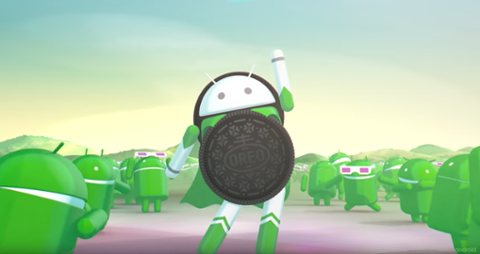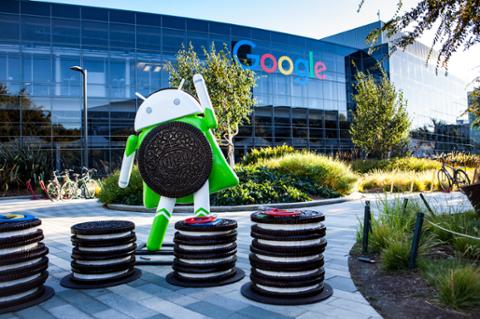 Android: It’s not just for mobile devices anymore. Google has announced an Open Automotive Alliance (OAA) that will attempt to “optimize” Android for in-vehicle use. Participating automobile manufacturers include Audi, GM, Hyundai and Honda; Nvidia is also a partner. “Wouldn't it be great if you could bring your favorite apps and music with you, and use them safely with your car's built-in controls and in-dash display?” read a Jan. 6 note on Google’s Official Android Blog. “Together with our OAA partners, we're working to enable new forms of integration with Android devices, and adapting Android for the car to make driving safer, easier and more enjoyable for everyone.” Putting Android into vehicles will “create new opportunities for developers to extend the variety and depth of the Android app ecosystem in new, exciting and safe ways,” the posting added. “But this is just the beginning; we welcome other automotive and technology companies to join the OAA, to work together to build a common platform to drive innovation in the car and bring Android to the open road.” The alliance is still very much in its early stages, with the first Android-integrated cars expected to hit the road by the end of 2014. Alliance members have reached out to the National Highway Traffic Safety Administration (NHTSA) in order to make the platform as safe as possible. (No word on whether Google will attempt to integrate Android with its self-driving cars.) Google isn’t the only tech company positioning its mobile OS as ideal for cars: over the past several months, Apple has reached agreements with a number of automobile companies (including Honda and Hyundai) to integrate Siri Eyes Free into the driving experience. Siri Hands Free allows drivers to dictate texts and emails, listen to incoming texts and emails, set up calendar entries and alarms, check the weather, navigate, and receive sports scores and stock quotes. Over the past few years, the rise of dashboard screens and embedded chips have brought the sci-fi dream of an in-vehicle computer to the verge of ubiquitous—maybe even mundane—reality. More and more vehicles feature dashboard screens that link to everything from Web browsers to cloud-stored music libraries. Yet despite the increasing sophistication of these onboard systems (and the probability that third-party developers will soon build progressively more apps for cars), safety remains a paramount concern; if you thought texting while driving was dangerous, imagine how bad things could get with multiple screens and even holographic overlays. Image: fujji/Shutterstock.com
Android: It’s not just for mobile devices anymore. Google has announced an Open Automotive Alliance (OAA) that will attempt to “optimize” Android for in-vehicle use. Participating automobile manufacturers include Audi, GM, Hyundai and Honda; Nvidia is also a partner. “Wouldn't it be great if you could bring your favorite apps and music with you, and use them safely with your car's built-in controls and in-dash display?” read a Jan. 6 note on Google’s Official Android Blog. “Together with our OAA partners, we're working to enable new forms of integration with Android devices, and adapting Android for the car to make driving safer, easier and more enjoyable for everyone.” Putting Android into vehicles will “create new opportunities for developers to extend the variety and depth of the Android app ecosystem in new, exciting and safe ways,” the posting added. “But this is just the beginning; we welcome other automotive and technology companies to join the OAA, to work together to build a common platform to drive innovation in the car and bring Android to the open road.” The alliance is still very much in its early stages, with the first Android-integrated cars expected to hit the road by the end of 2014. Alliance members have reached out to the National Highway Traffic Safety Administration (NHTSA) in order to make the platform as safe as possible. (No word on whether Google will attempt to integrate Android with its self-driving cars.) Google isn’t the only tech company positioning its mobile OS as ideal for cars: over the past several months, Apple has reached agreements with a number of automobile companies (including Honda and Hyundai) to integrate Siri Eyes Free into the driving experience. Siri Hands Free allows drivers to dictate texts and emails, listen to incoming texts and emails, set up calendar entries and alarms, check the weather, navigate, and receive sports scores and stock quotes. Over the past few years, the rise of dashboard screens and embedded chips have brought the sci-fi dream of an in-vehicle computer to the verge of ubiquitous—maybe even mundane—reality. More and more vehicles feature dashboard screens that link to everything from Web browsers to cloud-stored music libraries. Yet despite the increasing sophistication of these onboard systems (and the probability that third-party developers will soon build progressively more apps for cars), safety remains a paramount concern; if you thought texting while driving was dangerous, imagine how bad things could get with multiple screens and even holographic overlays. Image: fujji/Shutterstock.com Google Bringing Android to Your Car
 Android: It’s not just for mobile devices anymore. Google has announced an Open Automotive Alliance (OAA) that will attempt to “optimize” Android for in-vehicle use. Participating automobile manufacturers include Audi, GM, Hyundai and Honda; Nvidia is also a partner. “Wouldn't it be great if you could bring your favorite apps and music with you, and use them safely with your car's built-in controls and in-dash display?” read a Jan. 6 note on Google’s Official Android Blog. “Together with our OAA partners, we're working to enable new forms of integration with Android devices, and adapting Android for the car to make driving safer, easier and more enjoyable for everyone.” Putting Android into vehicles will “create new opportunities for developers to extend the variety and depth of the Android app ecosystem in new, exciting and safe ways,” the posting added. “But this is just the beginning; we welcome other automotive and technology companies to join the OAA, to work together to build a common platform to drive innovation in the car and bring Android to the open road.” The alliance is still very much in its early stages, with the first Android-integrated cars expected to hit the road by the end of 2014. Alliance members have reached out to the National Highway Traffic Safety Administration (NHTSA) in order to make the platform as safe as possible. (No word on whether Google will attempt to integrate Android with its self-driving cars.) Google isn’t the only tech company positioning its mobile OS as ideal for cars: over the past several months, Apple has reached agreements with a number of automobile companies (including Honda and Hyundai) to integrate Siri Eyes Free into the driving experience. Siri Hands Free allows drivers to dictate texts and emails, listen to incoming texts and emails, set up calendar entries and alarms, check the weather, navigate, and receive sports scores and stock quotes. Over the past few years, the rise of dashboard screens and embedded chips have brought the sci-fi dream of an in-vehicle computer to the verge of ubiquitous—maybe even mundane—reality. More and more vehicles feature dashboard screens that link to everything from Web browsers to cloud-stored music libraries. Yet despite the increasing sophistication of these onboard systems (and the probability that third-party developers will soon build progressively more apps for cars), safety remains a paramount concern; if you thought texting while driving was dangerous, imagine how bad things could get with multiple screens and even holographic overlays. Image: fujji/Shutterstock.com
Android: It’s not just for mobile devices anymore. Google has announced an Open Automotive Alliance (OAA) that will attempt to “optimize” Android for in-vehicle use. Participating automobile manufacturers include Audi, GM, Hyundai and Honda; Nvidia is also a partner. “Wouldn't it be great if you could bring your favorite apps and music with you, and use them safely with your car's built-in controls and in-dash display?” read a Jan. 6 note on Google’s Official Android Blog. “Together with our OAA partners, we're working to enable new forms of integration with Android devices, and adapting Android for the car to make driving safer, easier and more enjoyable for everyone.” Putting Android into vehicles will “create new opportunities for developers to extend the variety and depth of the Android app ecosystem in new, exciting and safe ways,” the posting added. “But this is just the beginning; we welcome other automotive and technology companies to join the OAA, to work together to build a common platform to drive innovation in the car and bring Android to the open road.” The alliance is still very much in its early stages, with the first Android-integrated cars expected to hit the road by the end of 2014. Alliance members have reached out to the National Highway Traffic Safety Administration (NHTSA) in order to make the platform as safe as possible. (No word on whether Google will attempt to integrate Android with its self-driving cars.) Google isn’t the only tech company positioning its mobile OS as ideal for cars: over the past several months, Apple has reached agreements with a number of automobile companies (including Honda and Hyundai) to integrate Siri Eyes Free into the driving experience. Siri Hands Free allows drivers to dictate texts and emails, listen to incoming texts and emails, set up calendar entries and alarms, check the weather, navigate, and receive sports scores and stock quotes. Over the past few years, the rise of dashboard screens and embedded chips have brought the sci-fi dream of an in-vehicle computer to the verge of ubiquitous—maybe even mundane—reality. More and more vehicles feature dashboard screens that link to everything from Web browsers to cloud-stored music libraries. Yet despite the increasing sophistication of these onboard systems (and the probability that third-party developers will soon build progressively more apps for cars), safety remains a paramount concern; if you thought texting while driving was dangerous, imagine how bad things could get with multiple screens and even holographic overlays. Image: fujji/Shutterstock.com 

